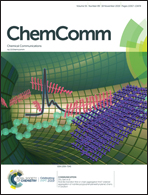Photo-controlled chirality transfer and FRET effects based on pseudo[3]rotaxane†
Abstract
The use of light to regulate the chirality of supramolecular assemblies in a non-invasive manner remains a challenge. Herein, we report a novel photochromic pseudo[3]rotaxane based on a (R/S)-2,2′-binaphthyl secondary ammonium salt guest (2) and anthracene-bridged bis(dibenzo-24-crown-8) (1), which features a chirality transfer and fluorescence resonance energy transfer (FRET) from 2 to 1. Benefiting from the photo-oxidation of anthracene, the induced circular dichroism (ICD) signals of (R/S)-2@1 can be switched off/on by irradiation with 365 nm UV light and heating. This noncovalent supramolecular assembly strategy provides us with unique opportunities to design and construct further smart photo-responsive chiral molecular switches.
![Graphical abstract: Photo-controlled chirality transfer and FRET effects based on pseudo[3]rotaxane](/en/Image/Get?imageInfo.ImageType=GA&imageInfo.ImageIdentifier.ManuscriptID=C9CC06917H&imageInfo.ImageIdentifier.Year=2019)


 Please wait while we load your content...
Please wait while we load your content...